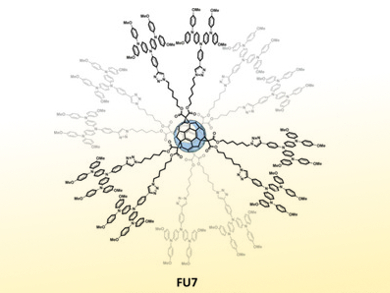Fullerenes have been extensively used in the field of organic solar cells, and more recently, also in perovskite solar cells (PSCs). The fullerenes show excellent photovoltaic behavior and improve the stability of PSCs. They have mainly been used as electron transport materials, but also as additives in the perovskite layer. The use of fullerene and fullerene-based molecules in PSCs has helped to reduce hysteresis, contributed to efficiency enhancement, and increased long-term stability.
Ramón Tena-Zaera, CIDETEC, Parque Tecnológico de San Sebastián, Spain, Iván Mora-Seró, University of Jaume I., Castelló de la Plana, Spain, Juan Luis Delgado, POLYMAT-University of the Basque Country, Donostia-San Sebastián, and Basque Foundation for Science, Bilbao, both Spain, and colleagues have tuned the electronic properties of fullerenes through synthetic chemical tools and, for the first time, obtained a fullerene material (FU7, pictured) which can act as an efficient hole-transporting/electron blocking layer in PSCs.
FU7 was prepared by a 12-fold copper-catalyzed alkyne-azide “click” reaction (CuAAC) between a C60 building block bearing 12 azide groups and 12 molecules of a large triarylamine. The team tested the material in perovskite solar cells (PSCs) and obtained efficient devices without any doping additive in the hole transporting material. Moreover, they prepared the first efficient PSC where both selective contacts are fullerene derivatives, i.e., “fullerene sandwich” PSCs. In a field where fullerenes have been solely exploited as electron transport materials, this finding offers new perspectives for their use as hole-transporting materials.
- Fullerene-Based Materials as Hole-Transporting/Electron Blocking Layers. Applications in Perovskite Solar Cells,
Juan L. Delgado, Luis E. Hueso, Elisabetta Zuccatti, Silvia Collavini, Sebastian F. Völker, Jorge Pascual, Ramón Tena-Zaera, Marta Vallés-Pelarda, Iván Mora-Seró, Fernando Ruiperez,
Chem. Eur. J. 2018.
https://doi.org/10.1002/chem.201801069




